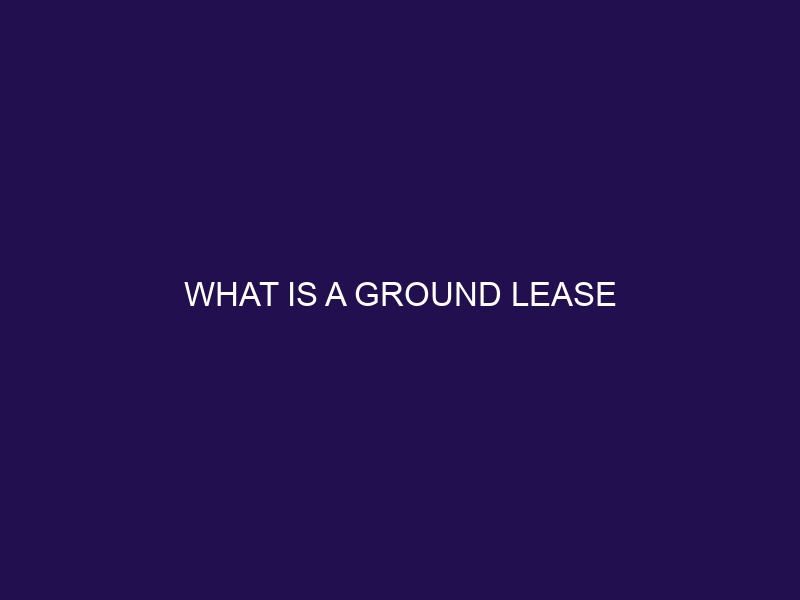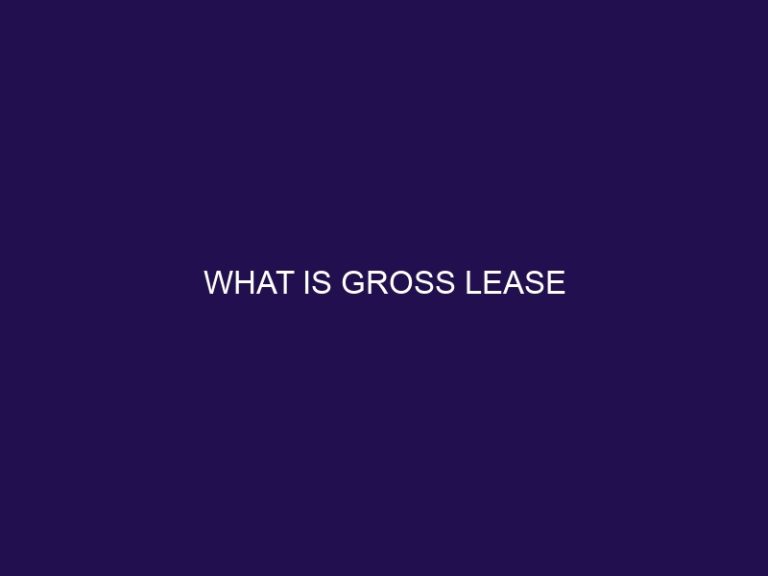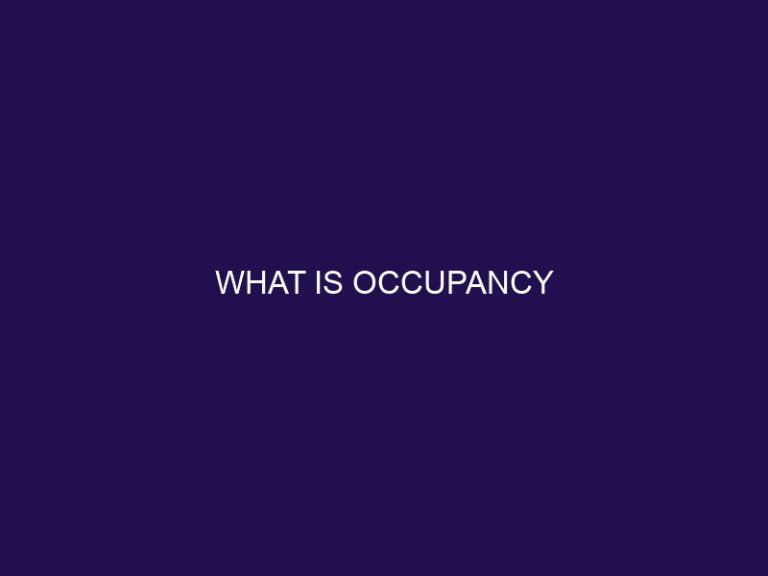What is a Ground Lease
html
Understanding Ground Lease
A ground lease is a type of lease agreement where a tenant leases land from the landowner for an extended period, typically ranging from 40 to 99 years. In this arrangement, the tenant is granted permission to use and develop the land while the landowner retains ownership of the land. It is an alternative to traditional fee simple ownership and is commonly used in commercial real estate and infrastructure development projects.
A ground lease has distinct features that differentiate it from other types of leases. It typically includes provisions for rent payments, lease duration, leasehold improvements, and rent escalation. Understanding the advantages and disadvantages of a ground lease is essential for both tenants and landowners considering this type of arrangement.
Advantages of a ground lease include a lower upfront cost for the tenant, as they do not have to purchase the land outright. It also allows for long-term planning and development, providing stability and predictability for businesses and investors. Ground lease terms may offer tax benefits and increased financing options for tenants.
However, there are also disadvantages to consider. Tenants may have limited control over the land, as the landowner typically retains certain rights and restrictions. Ground lease tenants may also face challenges in obtaining financing due to the nature of the leasehold interest. Rent may also escalate over time, potentially impacting the tenant’s profitability.
Key considerations in a ground lease include the length of the lease, leasehold improvements, and rent terms. The duration of the lease should align with the tenant’s long-term goals and allow sufficient time for the return on investment. Leasehold improvements, such as buildings or infrastructure constructed by the tenant, should be addressed in the lease agreement. Rent and rent escalation clauses should be carefully negotiated to ensure fairness and affordability for both parties.
It is important to understand the differences between a ground lease and fee simple ownership. Fee simple ownership grants the owner complete control and ownership rights over the land and improvements on it, while a ground lease allows for limited rights and control for the tenant. Assessing which option best suits your needs and circumstances is crucial when making decisions regarding land use and ownership.
Examples of ground leases can be found in various industries, including commercial real estate, renewable energy projects, and cell tower installations. These examples help illustrate the practical application and benefits of ground leases in different contexts.
Both legal and financial implications are associated with ground leases. Legal considerations involve drafting a clear and comprehensive lease agreement that addresses rights, obligations, and potential disputes. Financial considerations include the determination of fair market rent, evaluation of tax implications, and accounting for the long-term financial impact of the lease arrangement.
By understanding the concept of a ground lease and considering its advantages, disadvantages, key considerations, and legal and financial implications, individuals and businesses can make informed decisions when entering into such lease agreements.
Understanding Ground Lease
A ground lease, also known as a land lease, is an agreement where a tenant leases the land itself and constructs their own building or structure on it. It is important to have a clear understanding of ground leases. Here are some key points to consider:
- Long-term commitment: To understand ground leases, it is crucial to note that they typically have longer terms compared to traditional leases, lasting anywhere from 30 to 99 years.
- Land ownership: Throughout the lease term, the land remains owned by the landlord. However, the tenant gains exclusive rights to use the land and any improvements made on it.
- Rent payments: As part of the ground lease agreement, the tenant pays rent to the landlord for the use of the land. It is worth noting that the rent amount is usually lower when compared to a lease that includes both land and building.
- Structural control: An important aspect of understanding a ground lease is recognizing that the tenant has control over the design, construction, and maintenance of the building or structure on the leased land.
- Ownership transfer: Depending on the terms specified in the ground lease, the tenant may have the option to sell or transfer their leasehold interest to another party.
What is a Ground Lease?
A ground lease refers to a long-term agreement where a property owner grants exclusive rights to a tenant to develop and use the land. What is a Ground Lease? The tenant pays rent for the land but does not own it. Ground leases are commonly used in commercial real estate, allowing tenants to construct buildings without having to purchase the land. This arrangement offers advantages, What is a Ground Lease? such as lower upfront costs and tax benefits. It also has disadvantages, including limited control over the property and potential restrictions on leasehold improvements. Understanding the features, considerations, and implications of a ground lease is crucial before entering into such an agreement.
In a real-life scenario, a retail company entered into a ground lease with a landowner to build a new store. The lease enabled them to access a prime location without the need for a costly land purchase. What is a Ground Lease? Over time, the property’s value increased, and the tenant exercised their right to renew the lease, securing the long-term viability of their business. This ground lease allowed both parties to benefit from the arrangement and achieve their respective goals.
Features of a Ground Lease
- A ground lease has distinct characteristics that set it apart from other types of property ownership.
- Long-term lease: One notable feature of a ground lease is its duration, which often extends over multiple decades.
- Land ownership: Unlike other types of leases, in a ground lease, the landowner maintains ownership of the land while allowing the tenant to lease it.
- Leasehold improvements: Another feature of a ground lease is that the tenant has the right to construct buildings and make enhancements on the leased land.
- Rent payment: As part of the agreement, the tenant is responsible for paying rent to the landowner in exchange for using the land.
- Rent escalation: Rent in a ground lease can be subject to periodic increases, either prearranged or based on specific factors.
- End-of-lease arrangements: The lease agreement outlines what will happen to the improvements made on the land and the ownership of the land itself at the conclusion of the lease term.
Advantages and Disadvantages of Ground Lease
When it comes to ground leases, there are advantages and disadvantages to consider. In this section, we’ll explore the upsides and downsides of entering into a ground lease agreement. Discover the benefits that can come from a ground lease, as well as the potential drawbacks to be aware of. Whether you’re a landowner or considering leasing property, understanding these key points will help you make informed decisions and navigate the complexities of ground leases. Let’s dive in!
Advantages of Ground Lease
- Ground leases provide a steady stream of rental income for the landowner over an extended period. As a landowner, you don’t have to invest in constructing buildings or maintaining them. This reduces upfront costs and ongoing expenses. By leasing the land, you transfer the risk of property value fluctuations or market changes to the developer or tenant. Ground leases allow developers to invest in improvements and customize the property without the need for purchasing the land outright. Landowners can enjoy tax benefits, such as deducting property taxes and claiming depreciation on improvements made by the tenant.
A prime example of the advantages of ground lease is the partnership between The Port Authority of New York and New Jersey and Silverstein Properties. The ground lease for the World Trade Center site has enabled the developer to rebuild and revitalize the area without significant upfront costs, while the Port Authority continues to receive rental income.
Disadvantages of Ground Lease
- As a tenant, you have limited control over the property and may face restrictions on making changes or improvements.
- Unlike owning the property, you don’t build equity over time as you only have rights to use the land.
- The lease terms may include escalating rent, making it difficult to predict future expenses accurately.
- Lenders are often hesitant to provide loans for properties on ground leases, limiting your options for financing.
- Negotiating and renewing lease terms can be more complex and time-consuming than traditional property ownership.
Pro-tip: Before entering into a ground lease, thoroughly evaluate the financial implications, seek legal advice, and consider alternative ownership options.
Key Considerations in a Ground Lease
When diving into the key considerations of a ground lease, we uncover crucial factors that can greatly impact your lease agreement. From the length of the lease to leasehold improvements, and even the intricacies of rent and rent escalation, each aspect plays a vital role in shaping your experience as a lessee. So, let’s explore these sub-sections, unearthing valuable insights that’ll help you navigate the realm of ground leases with confidence and clarity.
Length of Lease
The length of lease is a crucial factor to take into account when entering into a ground lease agreement. Here are some important points to consider:
- Determine the initial lease term: The length of the lease should be negotiated and agreed upon by both parties. It is common for ground leases to have initial terms ranging from 20 to 99 years.
- Renewal options: It is important to consider whether the lease allows for renewal options. This will give you the opportunity to extend the lease beyond the initial term if desired.
- Understand the implications: The length of the lease can have significant financial and legal implications. Longer lease terms may provide more stability and potential for property appreciation, but they may also limit your flexibility in the future.
- Consider your goals: Evaluate your long-term goals and how the length of the lease aligns with them. If you are planning for future development or sale of the property, a shorter lease term may be more suitable.
- Seek legal advice: It is highly recommended to consult with a real estate attorney to thoroughly review the lease agreement and ensure that the length of the lease meets your specific needs and objectives.
In the early 1900s, ground leases with incredibly long terms, often spanning centuries, were commonly utilized. These leases served as a means for landowners to generate income while retaining ownership of the land. However, in recent years, shorter lease terms have become more prevalent as the needs and preferences of both landlords and tenants have evolved. Nowadays, the length of the lease remains a critical consideration in ground lease agreements.
Leasehold Improvements
The term “leasehold improvements” refers to changes or upgrades made by a tenant to a leased property. These improvements can enhance the functionality, aesthetics, or efficiency of the space. However, it is important to note that approval from the landlord is required, and these improvements must comply with the lease terms. When planning for leasehold improvements, consider the following:
1. Obtain Landlord Approval: It is crucial to obtain written consent from the landlord before undertaking any improvements. This ensures that the improvements align with the lease agreements.
1. Obtain Landlord Approval: It is crucial to obtain written consent from the landlord before undertaking any improvements. This ensures that the improvements align with the lease agreements. For more information on ground leases, you can refer to What is a Ground Lease.
2. Scope and Budget: Clearly define the scope of work and establish a budget to prevent unexpected expenses from arising.
3. Permits and Codes: Check local regulations and acquire the necessary permits to ensure compliance with building codes.
4. Professional Help: Engage professionals such as architects and contractors to assist with design, planning, and execution.
5. Return on Investment: Evaluate the potential value added by the improvements and consider their impact on future lease terms.
In a commercial lease example, a tenant decided to renovate the leased space to accommodate their growing business. The leasehold improvements included creating additional offices, upgrading the HVAC system, and installing modern lighting. These improvements not only boosted employee productivity but also enhanced the overall experience for clients, resulting in increased business and the successful renewal of the leasing agreement.
Rent and Rent Escalation
- Determine the initial rent: When entering into a ground lease agreement, it is crucial to negotiate the initial rent amount based on the market rates and the value of the property.
- Include rent escalation clauses: In order to account for potential increases in rent over the lease term, it is recommended to consider including provisions for rent escalation. This can involve annual or periodic increases tied to inflation or predetermined percentages.
- Review lease terms: It is important to carefully review the lease terms to fully understand when and how rent escalations will occur.
- Consider caps or limits: To protect against significant jumps in rent, it is advisable to discuss whether there will be any caps or limits on rent increases.
Remember to consult with legal and financial professionals to ensure a fair and favorable ground lease agreement.
Ground Lease vs. Fee Simple
Discover the key differentiators between ground lease and fee simple ownership in real estate. Delve into the various aspects of fee simple ownership and gain insights into how it differs from a ground lease. Uncover the unique characteristics and benefits each approach offers, shedding light on the essential factors that influence property ownership decisions. Get ready to explore the nuances that distinguish these two concepts and understand their implications in the ever-evolving world of real estate.
Understanding Fee Simple Ownership
Understanding fee simple ownership is crucial when considering a ground lease. Fee simple ownership entails owning both the land and the building on it. In contrast, a ground lease involves leasing the land while the building ownership remains separate.
In fee simple ownership, several key considerations come into play. These include the ability to make improvements to the property without restrictions, having complete control over the property, and the potential for greater appreciation in value over time. Additionally, the owner is responsible for all costs and maintenance of the property.
To make an informed decision about the best option for your specific circumstances and goals, it is vital to comprehend the distinctions between ground lease and fee simple ownership.
Differences Between Ground Lease and Fee Simple
When comparing the differences between a ground lease and fee simple ownership, there are several key factors to consider:
- Ownership: In a ground lease, the land is leased while the improvements on the land are owned by the tenant. Conversely, in fee simple ownership, the land and improvements are both owned by the same party.
- Duration: Ground leases typically have longer lease terms, usually lasting from 50 to 99 years. On the other hand, fee simple ownership is indefinite.
- Control: In a ground lease, the landlord has the authority to impose restrictions and regulations on the utilization and development of the land. In fee simple ownership, the owner has complete control over the property.
- Appreciation: With a ground lease, a tenant can potentially benefit from any increase in property value during the lease term. In contrast, fee simple ownership allows the owner to retain all appreciation.
- Residual Value: When a ground lease expires, the land and improvements automatically revert to the landlord. However, in fee simple ownership, the owner retains both the land and improvements even after the lease term ends.
Understanding these differences can greatly assist individuals in making informed decisions when deciding between a ground lease and fee simple ownership.
Examples of Ground Lease
Examples of ground lease agreements are found in various sectors such as commercial real estate, residential real estate, and the renewable energy sector. In commercial real estate, a ground lease allows a tenant to develop a property without the need for an outright purchase. This arrangement enables the tenant to lease the land and construct their own business on it. Similarly, in residential real estate, a ground lease is utilized for cooperative housing developments where residents lease the land as a group, with each member owning a share of the building. Additionally, in the renewable energy sector, companies often enter into ground leases to build solar or wind farms on leased land and sell the resulting energy. Ground leases offer mutual benefits, providing tenants with land access and landlords with rental income, all while relieving the landlord of the burdens of building and maintaining a structure.
Legal and Financial Implications of Ground Leases
Unravel the legal considerations and financial aspects that come with ground leases, and discover how they shape the real estate landscape. From understanding the legal intricacies to exploring the financial considerations, this section provides invaluable insights into the world of ground leases. Delve into the legalities and financial implications that can impact property owners, developers, and investors alike.
Legal Considerations
Legal Considerations are of utmost importance when entering into a ground lease. These Legal Considerations involve the careful review and understanding of the lease agreement’s terms and conditions. It is essential to ensure compliance with local zoning and land-use regulations and to seek appropriate legal advice to safeguard your interests. Thorough due diligence, including examining any restrictions or limitations mentioned in the lease, such as use restrictions, maintenance responsibilities, or insurance requirements, is crucial. Familiarizing oneself with the process of dispute resolution and the rights and remedies available to both parties is also significant. By taking these Legal Considerations into account, potential issues or conflicts in the future can be prevented.
Fact: Legal Considerations extend beyond the initial lease agreement and should be kept in mind throughout the duration of the ground lease to ensure continuous compliance and protection of rights.
Financial Considerations
When considering a ground lease, there are important financial considerations to keep in mind. Here is a breakdown of key factors:
| 1. Rent and Rent Escalation: | Understand the terms of rent payment and whether it will increase over time, affecting your financial obligations. |
| 2. Leasehold Improvements: | Consider any expenses associated with improving the leased property, as these can impact your overall financial position. |
| 3. Length of Lease: | Take into account the duration of the ground lease and how it aligns with your long-term financial goals or business plans. |
| 4. Financial Stability: | Assess the financial stability of the lessor, as their financial health can impact the stability and viability of the ground lease. |
Frequently Asked Questions
What is a ground lease?
A ground lease is an agreement where a tenant leases undeveloped commercial land from a commercial landlord. The tenant has the right to develop the property during the lease period and then turn it over to the owner.
What are the types of commercial leases?
There are different types of commercial leases, including gross leases and net leases. Gross leases require the tenant to only pay rent, while net leases shift expenses to the tenants.
What are the benefits of a ground lease for tenants?
A ground lease allows tenants to develop buildings in desirable locations without the need for a down payment, freeing up money for other purposes. Additionally, tenants have the opportunity to own any improvements made to the property during the lease period.
What are the benefits of a ground lease for commercial landlords?
Commercial landlords benefit from receiving worry-free income and potentially a lump-sum payment for the property. They also have ownership rights over any improvements made to the land when the lease expires.
What is the duration of a ground lease?
Ground leases typically have long terms, usually ranging from 20 to 40 years or even up to 99 years.
How does a ground lease valuation model work?
A ground lease valuation model can be used to assess the value of a ground lease property. This model takes into account factors such as the lease period, financing conditions, maintenance expenses, and the rights of the landlord and tenant.







